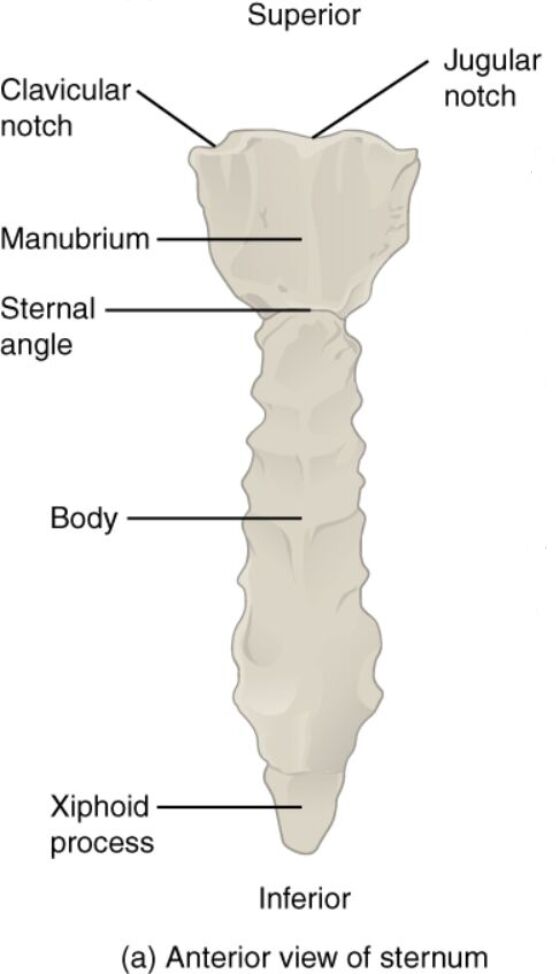The anterior view of the sternum provides a clear perspective on this central chest bone, which serves as a vital protector of the heart and major blood vessels. This flat, elongated structure connects the ribs and clavicles, playing a key role in maintaining thoracic stability and supporting respiratory movements, making it an essential focus for anatomical exploration.

Labels Introduction
Clavicular notch: The clavicular notch is a paired indentation on the superior border of the manubrium where the clavicles articulate, forming the sternoclavicular joint. This notch ensures a stable connection between the sternum and shoulder girdle, allowing for upper limb mobility.
Jugular notch: The jugular notch is a central depression at the top of the manubrium, serving as a palpable landmark for locating the internal jugular vein and other neck structures. It provides a reference point for clinical assessments and surgical approaches.
Recommended Study Resource
Gray's Anatomy: The Anatomical Basis of Clinical Practice
Enhance your anatomical knowledge with Gray's Anatomy: The Anatomical Basis of Clinical Practice. This authoritative text offers in-depth insights and illustrations, perfect for medical students and practitioners aiming for clinical excellence.
At AnatomyNote.com, we offer free resources on anatomy, pathology, and pediatric medicine for medical students and professionals. Purchasing through our Amazon links, like Gray's Anatomy, supports our server costs and content creation at no additional cost to you.
Disclosure: As an Amazon Associate, we earn a commission from qualifying purchases.
Disclosure: As an Amazon Associate, we earn a commission from qualifying purchases at no extra cost to you.
Manubrium: The manubrium is the uppermost, broad portion of the sternum that articulates with the clavicles and first two ribs, forming the superior part of the thoracic cage. It protects vital structures like the thymus gland and great vessels, such as the aorta.
Sternal angle: The sternal angle, or angle of Louis, is the transverse ridge where the manubrium meets the body of the sternum, marking the attachment of the second costal cartilage. This landmark is crucial for identifying rib levels and auscultating cardiac sounds.
Body: The body of the sternum is the longest middle segment, formed by the fusion of sternebrae, and connects with the costal cartilages of ribs 2 through 7. It provides a strong central support for the rib cage and protects the heart and lungs.
Xiphoid process: The xiphoid process is the small, cartilaginous lower tip of the sternum that ossifies with age, serving as an attachment site for the diaphragm and rectus abdominis muscles. It acts as a landmark for procedures like cardiopulmonary resuscitation.
Anatomy Flash Cards
Master anatomy with detailed, exam-ready flash cards.
AnatomyNote.com offers free anatomy and pathology resources. Your purchase of Anatomy Flash Cards supports our site at no extra cost.
As an Amazon Associate, we earn from qualifying purchases.
Detailed Anatomical Overview
Structure and Composition of the Sternum
The sternum, often called the breastbone, is a flat bone that forms the anterior midline of the thoracic cage. The clavicular notch and jugular notch define its superior boundary, offering accessible points for medical procedures and anatomical reference. This bone’s layered structure, including cortical and trabecular bone, provides both strength and flexibility.
- The manubrium is thicker and more robust to withstand forces from the clavicles and upper ribs.
- The sternal angle aligns with the second rib, serving as a guide for chest tube insertion or pericardiocentesis.
- The body supports the majority of the rib cage, distributing weight evenly across the thorax.
Functional Roles in the Body
The sternum’s design supports respiration by anchoring the ribs via the body and xiphoid process, allowing the thoracic cavity to expand. The jugular notch aids in assessing central venous pressure, a critical indicator in cardiovascular health. Its connections with the clavicles and ribs enhance upper body stability and movement.
- The clavicular notch facilitates shoulder motion by linking the clavicle to the sternum.
- The manubrium protects the great vessels, including the superior vena cava, from external trauma.
- The sternal angle marks the level of the pulmonary artery, guiding catheter placement.
Clinical Relevance and Landmarks
The sternum is a common site for medical interventions, with the xiphoid process serving as a reference for CPR compressions. The body can be a site for bone marrow biopsies due to its accessible marrow cavity. Understanding these landmarks improves diagnostic and therapeutic precision.
- The jugular notch can indicate tracheal deviation in cases of mediastinal shift or lung collapse.
- The clavicular notch may be involved in sternoclavicular dislocations, requiring imaging for assessment.
- The manubrium is a target in sternal fractures, often seen in high-impact trauma.
Supporting Structures and Their Importance
The sternal angle provides a reliable marker for counting ribs and intercostal spaces, essential for thoracic surgery. The body’s length accommodates the attachment of the pectoralis major, aiding in arm flexion and chest expansion. The xiphoid process supports the diaphragm, a primary muscle in breathing.
- The clavicular notch ensures the sternoclavicular joint’s stability, preventing dislocation during arm movements.
- The jugular notch is used to monitor jugular venous distension in heart failure cases.
- The manubrium and body together form a protective shield for the thymus, which produces T-lymphocytes for immune function.
The sternum’s anterior view highlights its role as a central pillar of the thoracic skeleton. Its labeled components work synergistically to protect vital organs, support respiration, and provide clinical landmarks. A thorough understanding of this structure enhances the ability to address chest-related conditions effectively.
Conclusion
The anterior view of the sternum reveals a critical component of the thoracic cage, safeguarding the heart and lungs while supporting respiratory function. This bone’s anatomical features, from the jugular notch to the xiphoid process, offer valuable insights for clinical practice and anatomical study. Exploring its structure deepens appreciation for its role in maintaining overall health and facilitating precise medical interventions.




